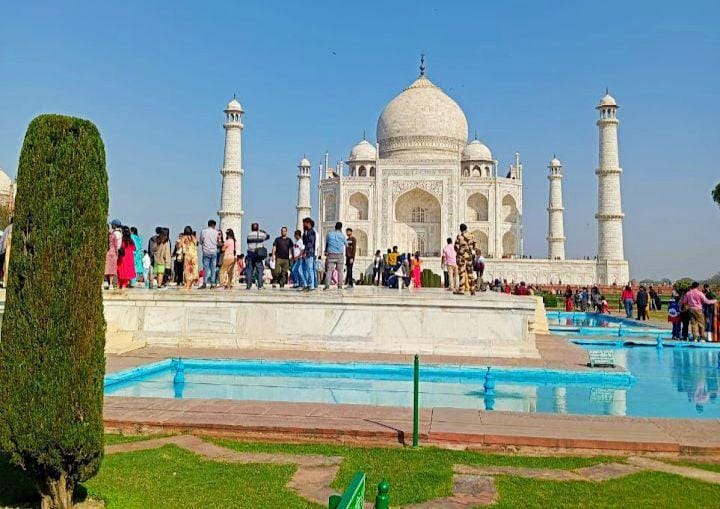
The Taj Mahal, located in Agra, Uttar Pradesh, India, is one of the most iconic and celebrated monuments in the world. It is renowned for its breathtaking beauty, architectural brilliance, and the poignant love story behind its creation. Here’s a detailed overview of its historical and cultural significance:
Historical Background:
- Commissioned by Shah Jahan:
- The Taj Mahal was built by the Mughal Emperor Shah Jahan (ruled 1628–1658) in memory of his beloved wife, Mumtaz Mahal, who died during childbirth in 1631.
- Mumtaz Mahal was Shah Jahan’s third wife and his favorite companion. Her death left him heartbroken, and he vowed to build a monument that would immortalize their love.
- Construction Period:
- Construction began in 1632 and was completed in 1653, taking approximately 22 years.
- The project involved over 20,000 artisans, craftsmen, and laborers from across India, Persia, the Ottoman Empire, and Europe.
- Architects and Design:
- The chief architect is believed to be Ustad Ahmad Lahori, though other architects and designers also contributed.
- The design combines elements of Persian, Islamic, and Indian architecture, creating a unique Mughal style.

Architectural Marvel:
- Materials and Craftsmanship:
- The Taj Mahal is built primarily of white marble, sourced from Makrana in Rajasthan.
- Precious and semi-precious stones, such as lapis lazuli, jade, crystal, turquoise, and sapphire, were used for intricate inlay work (pietra dura).
- The marble reflects different hues depending on the time of day—pinkish in the morning, milky white in the evening, and golden under moonlight.
- Layout and Design:
- The complex is symmetrically designed and includes:
- Main Mausoleum: The central structure housing the tombs of Mumtaz Mahal and Shah Jahan.
- Four Minarets: Flanking the mausoleum, each leaning slightly outward to protect the main structure in case of an earthquake.
- Gardens (Charbagh): Persian-style gardens divided into four quadrants by water channels, symbolizing paradise.
- Mosque and Guest House: Located on either side of the mausoleum for symmetry.
- The Yamuna River flows behind the Taj Mahal, adding to its scenic beauty.
- The complex is symmetrically designed and includes:
- Inscriptions and Calligraphy:
- The walls are adorned with Quranic verses and floral patterns. The calligraphy was created by Amanat Khan, a master calligrapher.

Symbolism and Significance:
- A Monument of Love:
- The Taj Mahal is often called a “teardrop on the cheek of eternity” and is considered the ultimate symbol of love.
- Shah Jahan’s grief and devotion to Mumtaz Mahal are immortalized in its grandeur.
- Cultural and Religious Significance:
- The Taj Mahal reflects the Mughal Empire’s grandeur and its fusion of Islamic and Indian cultures.
- It is also a symbol of eternity and paradise, as described in Islamic teachings.
- UNESCO World Heritage Site:
- The Taj Mahal was designated a UNESCO World Heritage Site in 1983 for its outstanding universal value and architectural brilliance.

Historical Events and Legacy:
- Shah Jahan’s Imprisonment:
- After the completion of the Taj Mahal, Shah Jahan was overthrown by his son, Aurangzeb, and imprisoned in the Agra Fort.
- From his prison, Shah Jahan could view the Taj Mahal, where he was eventually buried beside Mumtaz Mahal after his death in 1666.
- British Era and Restoration:
- During the British colonial period, the Taj Mahal suffered neglect and vandalism. Some precious stones were stripped from its walls.
- In the 19th century, Lord Curzon, the Viceroy of India, initiated restoration efforts to preserve its beauty.
- Modern-Day Conservation:
- The Taj Mahal faces threats from air pollution, acid rain, and environmental degradation due to industrialization in Agra.
- The Archaeological Survey of India (ASI) and other organizations are working to protect and conserve the monument.

Visiting the Taj Mahal:
- Best Time to Visit:
- October to March: The weather is pleasant, making it ideal for sightseeing.
- Sunrise or Sunset: The Taj Mahal’s changing colors during these times are mesmerizing.
- Interesting Facts:
- The Taj Mahal is one of the New Seven Wonders of the World.
- It attracts over 7–8 million visitors annually.
- The construction cost is estimated to be around 32 million rupees (equivalent to billions today).
Conclusion:
The Taj Mahal is not just a monument but a testament to love, art, and human ingenuity. Its timeless beauty and historical significance continue to captivate people from around the world, making it a must-visit destination and a proud symbol of India’s rich cultural heritage.










Add comment